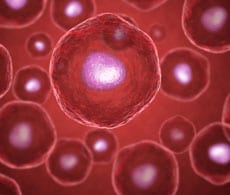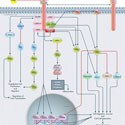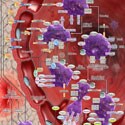Search
细胞信号传导通路

细胞信号传导通路和免疫学相关通路
要查看可用的通路,请点击下方您感兴趣的生物学领域名称。选择通路后,您可以查看通路图像,深入了解通路的科学原理,查阅参考文献,并链接到涉及该通路抗原的产品。
选择生物学领域以查看相关细胞信号传导通路

适应性免疫
脊椎动物清除身体病原体有两种方法,适应性免疫便是其中之一。适应性免疫系统会针对特定病原体提供长期保护。有多种细胞信号传导通路涉及这一生物学领域,包括 AKT 细胞信号传导通路,FAS 细胞信号传导通路和 RANK 通路。

粘附和迁移
细胞粘附是一个细胞与另一个细胞或细胞外基质 (ECM) 的相互作用,通过该作用可实现细胞迁移和组织维持。该生物学领域包含的两个细胞信号传导通路是粒细胞粘附和渗出以及白细胞跨内皮细胞迁移。
血管新生
血管新生是形成新血管的过程。它在生长和开发以及伤口愈合中都非常重要,但在肿瘤发生中也起着重要作用。有多种血管新生通路,包括血管生成素 -Tie2 信号转导以及 VEGF 配体家族和受体相互作用。
细胞凋亡
凋亡是多细胞生物中调控细胞死亡的严格调节过程。虽然它是一个有利且通常有益的过程,但其可能不受控制,进而导致细胞生长和肿瘤发生不受控制。有多个重要的通路都属于细胞凋亡,包括 AKT 信号转导和 p53 介导的细胞凋亡通路。
骨生物学
骨骼是一种重要的组织,它可为体内提供支持,保护器官,产生血细胞和储存矿物质。有多条细胞信号传导通路参与骨发育和生长以及骨重塑,包括 BMP 和 RANK 通路。
肿瘤生物学
癌症是一种由细胞生长异常引起的疾病,并且可能发生转移或扩散到身体其他部位。环境毒素和基因突变可能在肿瘤的发生中发挥作用。癌症生物学中最重要的通路包括 ERBB 家族通路,p53 介导的细胞凋亡通路以及 GSK3 细胞信号传导通路。
细胞周期和增殖
细胞增殖是细胞分裂并使其自身复制的过程。许多信号转导分子,特别是生长因子,必须影响细胞周期,才能成功实现增殖。该过程在发育过程中最为活跃,并且涉及多种通路,包括 AKT 信号转导和 TNF 超家族通路。
细胞因子、趋化因子、生长因子
细胞因子,趋化因子(一种细胞因子)和生长因子均为充当免疫信号转导分子的蛋白质。它们在调节适应性和固有免疫反应以及调节某些细胞群方面有着许多作用。有大量通路属于这一生物学领域,包括 IL-22 和 TWEAK 通路。
先天免疫
脊椎动物清除身体病原体有两种方法,先天免疫便是其中之一。与适应性免疫系统不同,先天免疫系统不会对特定病原体提供长期免疫。有多种细胞信号通路涉及该生物学领域,包括血管新生素 -Tie2 信号转导通路、GSK3 信号转导通路和巨噬细胞中的 CCR5 通路。
代谢
代谢是指在生物体内发生以维持其生命的所有化学反应,包括但不限于消化。代谢过程会将食物转化为细胞用于执行身体功能、构建蛋白质、脂肪和其他重要分子以及排除废物的能量。有许多信号通路涉及代谢,包括 AKT 和 GSK3 信号转导通路。
干细胞生物学
干细胞是未分化的细胞,既能分化为任何类型的细胞,又能持续不断地分裂——也就是所谓的自我更新。有两种主要类型的干细胞,胚胎干细胞和成体干细胞,现在这两种干细胞都被广泛用于研究、工程和疾病模型构建中。有大量的通路涉及该领域,包括 BMP 和 FGF 通路。
转录因子
转录因子是 DNA 结合蛋白,可调节基因表达。在此过程中,它们可以增加或减少特定基因的转录水平。由于转录因子会影响蛋白质的生成,而蛋白质本身也可以用作信号转导分子,因此有多种通路涉及该区域,包括 AKT、JAK/STAT 和 MAPK 家族通路。
抗体资源库
有针对性地收集科学应用说明、方法和细胞信号图。










